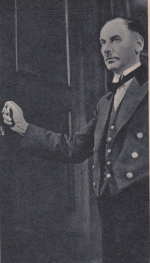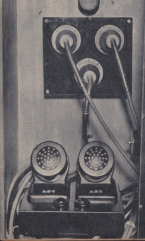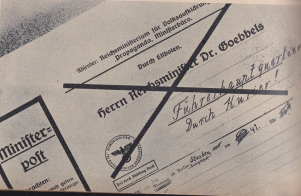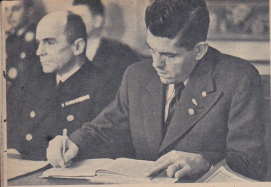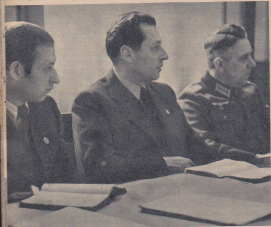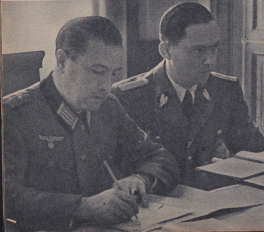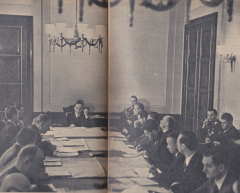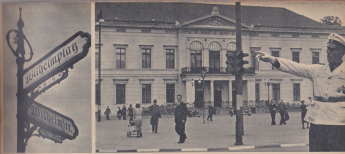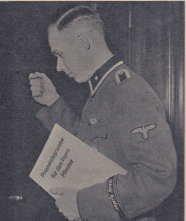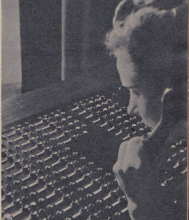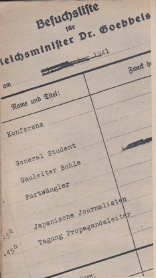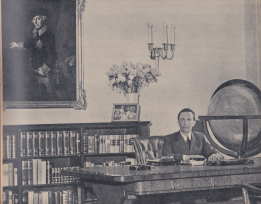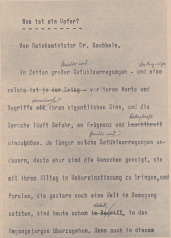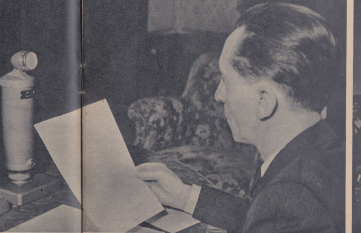Background: Signal was a bi-monthly propaganda periodical published in two dozen languages. This interesting 1942 article discusses the activities of Goebbels’s propaganda ministry. I find the most interesting aspects to be the photographs, which I append at the end. The images on this page are thumbnails.
For Goebbels’s account of his daily routine, see his article “Does the Government Know about That?”
I have compared the German version translated here with the English edition. The English edition is somewhat condensed and includes only ten of the fifteen pictures in the German edition.
The source: Rudolf Semler, “Wilhelmplatz 8/9. In der Befehlstelle von Reichsminister Dr. Goebbels,” Signal, 1. August 1942, pp. 13-17.
Wilhelmplatz 8/9
Dr. Goebbels’s Command Post
Berlin on a Sunday morning. It is a city that has slept in late to recover after a 70-hour work week. The streets are deserted, the trams half full, occasional pedestrians in their Sunday best, here and there a group of Hitler Youth marching. The lads’ faces are fresh and rosy, their songs echoing through the empty streets. They are heading out from the city, characterized today by a refreshing, or perhaps desolate, silence when compared to busy work days.
Only in the government district, next to the city’s deserted banks and commercial buildings, does one sense normal activity. There has not been a Sunday at the Wilhelmplatz for a long time. “At least three years,” sighs a porter. It is a day like any other. One person notices by accident, another with perhaps a sense of exhaustion, that the numbers on the calendar today are in red.
Here, however, one knows full well that the world does not stop after the sixth day. From here, in fact, it gets a constant series of new impulses. The printing presses are running and the radio is sending news to all parts of the earth. At the front, Stukas are dropping bombs and sharp eyes are watching for torpedoes in the Atlantic. The intellectual battles goes on as well. Perhaps a new round will begin today!
The innocent foreigner may not realize the fast pace of business that has gone on inside the white palace at Wilhelmplatz 8/9 ever since its new master moved in on 13 March 1933. He might miss the long line of small and rather old cars of every make and color parked early Sunday morning. The enchanting little palace — one of the most beautiful buildings in the Reich capital — has become one of the most modern ministries in the world under Dr. Goebbels. Many an attempt that other countries have made to imitate the worldwide impact of this building have, with few exceptions, failed.
Day and night, one feels here the pulse of the political world. Know-it-alls during peace knew the “unmistakable” signs that suggested thunderclouds on the political horizon. During the war, many passers-by during the week wish they could see behind the curtains or look through the windows, of the Führer's dwelling or the Propaganda Ministry, thereby catching a hint of the mystery that surrounds this place. When the Führer is at his headquarters or when he is seemingly resting at the Berghof, the curiosity of visitors to Wilhelmplatz focuses on the Propaganda Ministry. Mostly, these visitors are soldiers passing through or on leave. There are even certain times — or so a foreign journalist recently wrote — when one can sense what is going on politically or militarily, even when the newspapers have been ordered to keep silent, as is sometimes necessary. On the eve of political or military events, the Wilhelmplatz has its own exciting political atmosphere. Then one has the feeling that are gathering just before lightning flashes, that the secrets in the filing cabinets and offices of the Minister, the state secretaries, and high officials, have increased to the point that there is hardly room for them any longer.
They seem to be escaping through the windows, where curious visitors hope to catch one as it flutters by. It was that way during the last days of August 1939, or on 5 April 1941 as the Balkan campaign began, and other times as well.
For years there has been a tall blond traffic policeman in a while coat at the Wilhelmplatz, looking like someone out of the old sagas. Siegfried is the most popular policeman in the Reich capital. He knows all the ministers and leaders of the government and military personally. Journalists know him and ask questions, as do diplomats and greater and lesser officials. He knows a great deal, probably because he sees the constant coming and going in the government district. However, he is also aware of the responsibilities of his position and speaks only when he thinks it necessary, He is a propagandist who is at home on the Wilhelmstraße.
The Wilhelmplatz has a kiosk that sells postcards and Berlin souvenirs. It helps visitors see into the private sphere of the government district. Many postcards depict Edda, Göring’s little girl, playing with a little lion or sitting on the shoulders of her beaming father. Others show Dr. Goebbels and his family. His seven children [there were actually six] are second only to the eight children of Finance Minister Count Schwerin von Krosigk, the minister with the most children in a government that praises many children as a necessity.
Dr. Goebbels rides up the ramp to his ministry at 9 a.m. sharp in a small car, but the visible business begins just before 11 a.m. Insistent people catch the minister as soon as he arrives, and although his daily calendar is fixed to the minute, Dr. Goebbels often take the time to listen to the problems of people he does not know, who feel that they have somehow been treated unjustly.
A series of conferences, meetings, and appointments takes him into the afternoon. Then there is a line of quick visits from prominent people, delegates, ministers, generals, arts, and journalists, mostly in uniform but sometimes in suits and top hats. They pass through the main entrance under a large National Socialist symbol of iron. They are received by a servant in elegant dress. He knows how to greet foreign guests in all the important languages of the world. Visitors are examined carefully, but the experienced servant knows hundreds of people in public life, Germans and foreigners alike, who have often been on the Propaganda Minister’s list of visitors in recent years.
Over the years, the Propaganda Ministry has become a huge institution, a political agency that reaches into all areas of public — to the good fortune of those involved — and private life
The many offices are no longer all housed on the Wilhelmplatz. They are spread throughout the whole city and into the most distant suburbs. This becomes clear when one thinks, for example, that the Reich Chamber of Culture alone, which has charge of all cultural activities in the Reich, has about 800,000 members and requires a large administrative apparatus, all of which reaches into the Propaganda Ministry. Although the Ministry’s work has increased greatly since its foundation, the goal has been to avoid beauracracy has much as possible and to use as little paper as possible. That also demonstrates what is new in this building. It does not do things the old way, but uses all the technical means that are available today. Files are less important here than the telephone, teletype, and radio. Speed is the greatest commandment for a ministry that is charged with caring for and leading the people politically, intellectually, and spiritually. The press and radio are the most important of the available means.
That is why every morning around 11:00 official cars of the government, party offices, and the military carry officers, officials, and political leaders to the Minister’s conference at the Wilhelmplatz. The big Mercedes and Horch from peacetime have entirely vanished. Small cars fill the picture. Couriers on motorcycles weaning long gray raincoats go past. Older officials, schoolboys and women of varying ages bring sealed portfolios. The small crowd of curious onlookers who are always there watch this “government business” with interest. General staff officers with red stripes hurry through the entrance. Now a car with the sign “Greater German Radio” stops at the entrance.
Dr. Goebbels himself presides at the daily Minister’s conference. There are hundreds of telegrams from abroad, press reports, and enemy lies over the radio. There are situation reports from the Reich and occupied territories, proposals for laws. There are suggestions and wishes from other ministries and reports about the situation on the fronts. These documents and materials are the basis on which the Minister builds the daily operation plan for political propaganda. the themes of the day. Directives for propaganda offices and guidelines for large and small propaganda activities follow.
The expression “medical collective,” which the Minister himself once used for this meeting, is probably the best term for what happens here, for the seriousness and sense of responsibility. It suggests the care that is taken each day for the political health and spiritual powers of resistance of 80 million Germans.
Whatever may concerns the public, there is nothing of public interest that is not treated in a helpful and useful way. The discussion is often lively within this small group. Dealing with such things is an essential task of this daily meeting.
Photographs from the Article
